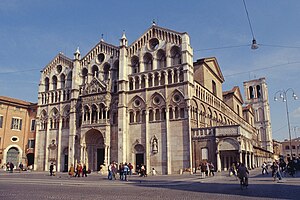Ferrara Cathedral
The Ferrara Cathedral (Basilica Cattedrale di San Giorgio) is a Roman Catholic church in the northern Italian city of Ferrara . It is the mother church of the Archdiocese of Ferrara-Comacchio and the largest religious building in the city. It is dedicated to St. George , who is also the patron saint of Ferrara.
The cathedral is located in the city center in the immediate vicinity of the Palazzo Comunale , i.e. the town hall. The famous Castello Estense is also not far away. The cathedral is connected to the archbishop's palace by a covered passage. The Romanesque- Gothic cathedral was recognized by UNESCO as a World Heritage Site as part of the historic city center of Ferrara .
Art and history
Construction of the cathedral began in the 12th century when the city on the left side of the Po River expanded and the center of the city shifted northward. The former cathedral, which was also consecrated to St. George, still exists today as a parish church on the right bank of the river outside the city walls. The new cathedral was consecrated in 1135, as evidenced by an inscription in the atrium of the church.
The cathedral was originally designed and started in the Romanesque style, but after various additions and alterations it shows features from very different style periods. The magnificent front facade made of white marble with the three points, the arcades and small rosettes, the statues and numerous reliefs clearly shows the Romanesque style and has loggias similar to the facades of the Cathedral of Modena and the Cathedral of Parma . The entrance portal with the wonderful reliefs created by the builder Nicholos also dates from the early days.
In the middle of the facade, a balcony is built like a vestibule, which is held by two columns that are placed on two lions at the base. In the upper part of the vestibule, the Last Judgment is depicted, which comes from an unknown master. In a loggia below there is a 'Madonna and Child' in Gothic style, which was added later. The lunette directly above the lintel of the entrance door shows St. George fighting the dragon. Scenes from the life of Christ appear on the lintel. The posts of the entrance are decorated with figures depicting the Annunciation and four prophets foretelling the coming of Christ.
According to an inscription that has since been destroyed, the portal, like possibly other parts of the building, was made by the sculptor Nicholas. The two side portals on the west facade are also attributed to him, as well as another large portal that stood on the south side but was demolished during the restoration in the 18th century. Several sculptures that adorned this gate and have been preserved are exhibited in the cathedral's museum.
On the south side there is also the campanile made of white and pink marble, which was built between 1451 and 1493 in the Renaissance style, but was not completed. The design for the bell tower is attributed to Leon Battista Alberti.
On the west side of the cathedral is the so-called Loggia dei Merciai , in which the shops of the traders were already in the Middle Ages. Above this loggia there are two rows of arches that rest on small columns. The outer walls of the apse with the brick arches and the marble capitals are the work of the builder and city planner Biagio Rossetti from Ferrara.
organ
The cathedral organ has 37 stops on three manuals and a pedal . The actions are mechanical.
|
|
|
|
||||||||||||||||||||||||||||||||||||||||||||||||||||||||||||||||||||||||||||||||||||||||||||||||||||||||||||||||||||||||||||||||||||||||||||||||||||||||||||||||||||||||||||||||||
- Coupling: II / I, III / I, I / P, II / P, III / P
Altarpiece
The altarpiece of Christ on the cross, whose trunk includes St. Magdalena. was designed by Dosso Dossi .
Individual evidence
- ↑ Information on the organ ( Memento from May 5, 2014 in the Internet Archive ) (PDF; 24 kB)
- ↑ DIRECTORY OF THE v.DERSCHAUISCHE Kunstkabinett zu NÜRNBERG .... Nuremberg, at the obligated auctionator Schmidmer., 1825., 250 p., Directory of rare art collections., 1825., Google Books, online , p. 21 ( The same painting was modified by him as an altarpiece in the Cathedral of Ferrara .)
Web links
Coordinates: 44 ° 50 ′ 7.8 " N , 11 ° 37 ′ 13.1" E










